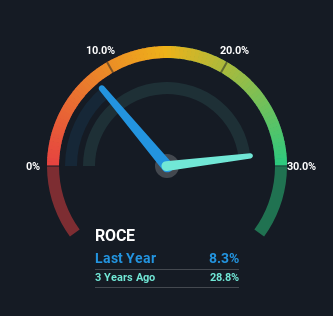- Hong Kong
- /
- Medical Equipment
- /
- SEHK:1858
The Returns On Capital At Beijing Chunlizhengda Medical Instruments (HKG:1858) Don't Inspire Confidence

Finding a business that has the potential to grow substantially is not easy, but it is possible if we look at a few key financial metrics. Typically, we'll want to notice a trend of growing return on capital employed (ROCE) and alongside that, an expanding base of capital employed. Ultimately, this demonstrates that it's a business that is reinvesting profits at increasing rates of return. Although, when we looked at Beijing Chunlizhengda Medical Instruments (HKG:1858), it didn't seem to tick all of these boxes.
What Is Return On Capital Employed (ROCE)?
For those who don't know, ROCE is a measure of a company's yearly pre-tax profit (its return), relative to the capital employed in the business. The formula for this calculation on Beijing Chunlizhengda Medical Instruments is:
Return on Capital Employed = Earnings Before Interest and Tax (EBIT) ÷ (Total Assets - Current Liabilities)
0.083 = CN¥252m ÷ (CN¥3.5b - CN¥515m) (Based on the trailing twelve months to March 2024).
So, Beijing Chunlizhengda Medical Instruments has an ROCE of 8.3%. On its own that's a low return on capital but it's in line with the industry's average returns of 8.4%.
See our latest analysis for Beijing Chunlizhengda Medical Instruments

Above you can see how the current ROCE for Beijing Chunlizhengda Medical Instruments compares to its prior returns on capital, but there's only so much you can tell from the past. If you're interested, you can view the analysts predictions in our free analyst report for Beijing Chunlizhengda Medical Instruments .
The Trend Of ROCE
In terms of Beijing Chunlizhengda Medical Instruments' historical ROCE movements, the trend isn't fantastic. To be more specific, ROCE has fallen from 21% over the last five years. On the other hand, the company has been employing more capital without a corresponding improvement in sales in the last year, which could suggest these investments are longer term plays. It's worth keeping an eye on the company's earnings from here on to see if these investments do end up contributing to the bottom line.
On a side note, Beijing Chunlizhengda Medical Instruments has done well to pay down its current liabilities to 15% of total assets. So we could link some of this to the decrease in ROCE. What's more, this can reduce some aspects of risk to the business because now the company's suppliers or short-term creditors are funding less of its operations. Some would claim this reduces the business' efficiency at generating ROCE since it is now funding more of the operations with its own money.
The Bottom Line On Beijing Chunlizhengda Medical Instruments' ROCE
To conclude, we've found that Beijing Chunlizhengda Medical Instruments is reinvesting in the business, but returns have been falling. Although the market must be expecting these trends to improve because the stock has gained 67% over the last five years. But if the trajectory of these underlying trends continue, we think the likelihood of it being a multi-bagger from here isn't high.
On a final note, we've found 1 warning sign for Beijing Chunlizhengda Medical Instruments that we think you should be aware of.
While Beijing Chunlizhengda Medical Instruments isn't earning the highest return, check out this free list of companies that are earning high returns on equity with solid balance sheets.
Valuation is complex, but we're here to simplify it.
Discover if Beijing Chunlizhengda Medical Instruments might be undervalued or overvalued with our detailed analysis, featuring fair value estimates, potential risks, dividends, insider trades, and its financial condition.
Access Free AnalysisHave feedback on this article? Concerned about the content? Get in touch with us directly. Alternatively, email editorial-team (at) simplywallst.com.
This article by Simply Wall St is general in nature. We provide commentary based on historical data and analyst forecasts only using an unbiased methodology and our articles are not intended to be financial advice. It does not constitute a recommendation to buy or sell any stock, and does not take account of your objectives, or your financial situation. We aim to bring you long-term focused analysis driven by fundamental data. Note that our analysis may not factor in the latest price-sensitive company announcements or qualitative material. Simply Wall St has no position in any stocks mentioned.
About SEHK:1858
Beijing Chunlizhengda Medical Instruments
Beijing Chunlizhengda Medical Instruments Co., Ltd.
Flawless balance sheet with high growth potential.
Similar Companies
Market Insights
Community Narratives




